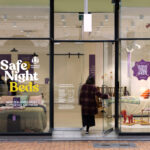Media release 13th March 2024
Initial insights from groundbreaking research Safer When, Safe How reveals the invisible risks of family violence
Women’s Refuge, with generous support from Contact Energy, is partway through a groundbreaking research project – Safer When, Safer How. Never undertaken in New Zealand, the research is examining family violence risk and what really works to make women safer.
Women’s Refuge routinely carries out assessments with women reaching out for assistance to determine their level of risk. Taking a data driven approach, the first phase of Safer When, Safer How analysed 3500 assessments completed over the past year.
Dr Ang Jury ONZM, CEO, Women’s Refuge says the initial results of this analysis were startling.
“We knew that many women who reached out for help were at a critical point, however we were stunned at the high number of women that are at risk of extreme violence or death. We are not talking about minor incidents here but women whose lives are at risk.”
It also found that women reach out to Refuge when the risk to them is highest. Nearly half experienced a worsening of the abuser’s physical violence in the weeks before reaching out to Refuge. Sixty percent saw intensified intimidating behaviour right before accessing Refuge, and nearly 60 percent found that their abusers stepped up the violence each time they put any safety measures in place.
The data provided crucial insight into the many and varied ways that family violence perpetrators use coercion to get what they want. Most go unseen by others, but seriously impact how safe women and children can be, how healthy they can be, and what resources they can have even long after the violence stops.
• One third were told to hurt or kill themselves
• One half were stopped from having their own money
• 45% were made to hand over all their private messages
• One fifth of those physically assaulted lost consciousness from the assault
• 72% had most of what they did every day controlled by the perpetrator
• 86% were constantly accused of doing something wrong
• 26% had their property (e.g walls or windows) damaged
To keep control, their abusers threatened to share information about their:
• Income/benefits: 1/4
• Mental health: 47%
• Parenting: 43%
• Previous sexual experiences: 20%
These forms of abuse leave an imprint on women’s lives even if they get free from the abuser.
“It leaves women to deal with all these other invisible problems, including money, housing, childcare, and health issues. But because the abuse and coercion is so invisible, everyone else might just see these as unrelated issues or needs. Even more concerningly, they might just be seen as bad choices the victim is making, when really we should be seeing how abuse takes away all her choices.”
“The risk assessment data reveals to us more of what’s in the abuser’s toolbox of control and coercion, and why that disables so many ‘choices’ that victims are assumed to have.”
“Seeing it on a grand scale can feel pretty hopeless, but having a deeper and more nuanced picture of violence and coercion also shows us so many more ways we can combat those impacts on women’s and children’s lives and futures.”
The results of phase one of Safer When, Safer How has implications beyond specialist services.
“We are often asked how you can help someone you know when someone’s abusing them. Anyone supporting a victim can play a really significant role by helping out with the extra burdens that abuse leaves in its wake. You don’t have to be an expert in solving the violence, or even know all the details of the abuse, to help remove some of that burden on her. That can be things like offering your time, help with childcare, financial support, emotional support, a safe place, validation, or taking some of the practical or life admin tasks off her.”
“Family violence can seem like a big, scary, complex problem, and people often want to help those harmed by it but don’t know how. As this research highlights, helping out in practical ways can have an enormous difference by restoring some of the time, energy, emotional capacity, sleep, money, wellbeing, opportunity and credibility that the perpetrator took away – and that counts for a lot in terms of how safe women can be.”
The next phase of the Safer When, Safer How will look further at the ways in which any person in any role, formal or informal, can be part of addressing family violence risks and responding in ways that make a genuine and sustainable difference to women’s and children’s safety.
Editors Notes:
Family Violence Statistics
• On average 50,000 women and children are referred to Women’s Refuge each year.
• On average Women’s Refuge answers 71 crisis calls per day.
• New Zealand has the highest rates of family violence in the OECD.
• 1 in 3 women will experience abuse in their lifetime in Aotearoa.
• Nearly half of all homicides and reported violent crimes are related to family violence.
• Around 67% of family violence episodes go unreported.
Partnership with Contact Energy
In addition to funding this research, since announcing its commitment to help those experiencing family violence in New Zealand, Contact has also:
• Gifted over $400,000 of electricity and broadband to Women’s Refuge’s 70 refuges and safe houses across Aotearoa New Zealand since July 2022.
• Enabled Women’s Refuge clients to set up electricity accounts regardless of their credit history.
• Added the ‘shielded’ functionality to its website to allow women to access information about how they can get help, without leaving a trail for an abusive partner to see.








